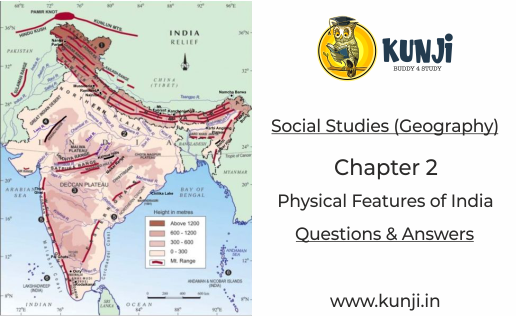NCERT solutions for class 9 Social Studies (Geography) Chapter 2- Physical Features of India
Here are the solutions for Chapter 2 of Geography for class 9. You can also check NCERT solutions for class 9th for all subjects.
Q1. Choose the Right answer from the four alternatives given below
- A landmass bounded by the sea on three sides is referred to as
a) Coast
b) Island
c) Peninsula
d) none of the above
Ans : c) Peninsula - Mountain ranges in the Eastern part of India forming its boundary with Myanmar are collectively called Eid
a) Himachal
b) Uttarakhand
c) Purvanchal
d) none of the above
Ans: c) Purvanchal - The Western Coastal strip south of Goa is referred to as
a) Coromandel
b) Konkan
c) Kannad
d) Northern Circar
Ans: (c) Kannad - The highest peak in the Eastern Ghats is
a) Anai Mudi
b) Kanchenjunga
c) Mahendragiri
d) Khasi
Ans: c) Mahendragiri
Q2. Answer the following questions briefly.
- What is the bhabar?
Ans: The northern plains are generally described as flat lands.there is a misconception that there is no variation in its relief. These Plains also have diverse relief features. According to the variation in relief features, the northern plains can be divided into four regions. The rivers, after descending from the mountains deposit pebbles in a narrow belt of about 8 to 16 kilometres in width lying parallel to the slopes of the Shivaliks full stop this region is known as bhabar. - Name the three major divisions of the Himalayas from north to south
1. The northern most range is known as the Great or Inner Himalayas or Himadri
2. Himachal or lesser Himalayas
3. Outer Himalayas or Shivaliks. - Which plateau lies between the Aravali and the Vindhya ranges?
Ans: The Malwa plateau lies between Aravali and Vindhya ranges - name the island group of India having a coral origin
Ans: Lakshadweep Island is the island group of India having a coral origin.
Q3. Distinguish between
1. Bhangar and Khadar
Bhangar
1. Bhangar lies above flood Plains of the rivers
2. older alluvium or old soil and forms the largest part of the northern plains
Khadar
1. The deposit of flood Plains and is renewed every year
- The Western Ghats and the Eastern Ghats
Ans: The Western Ghats
1. Lies parallel to The Western coast
2. They are continuous and can be crossed through passes only
3. Average elevation is 900 to 1600 metres
4. Because orographic Rain by facing the rain bearing moist winds to rise along the Western slopes of the Ghats
5. The height of the Western Ghats increases from north to south
The Eastern Ghats
1. Lies parallel to the eastern coast
2. They are discontinuous and irregular
3. They are dissected by rivers flowing into the Bay of Bengal
4. The average elevation of eastern Ghats is 600
Q4. Which are the major physiographic divisions of India? Contrast the relief of the Himalayan region with that of the peninsular plateau.
Ans: The major physiographic divisions of India are
The Himalayan mountains
The northern plains
The peninsular plateau
The Indian desert
The coastal plains
The Islands
Contrast the relief of the Himalayan region with that of the peninsular plateau.
The peninsular plateau is made up of ancient land masses on the earth surface. it was supposed to be one of the most stable land blocks. The Himalayas are the most recent landforms. From the viewpoint of geology Himalayan mountains form an unstable zone the whole mountain system of Himalaya represents a very youthful topography with high peaks, deep valleys and fast flowing rivers. the northern plains are formed of Alluvial deposits. The peninsular plateau comprises of igneous and metamorphic rocks with gently rising Hills and wide valleys.
Q5. Give an account of Northern Plains of India.
The northern plains are the most recent landforms. They are formed of Alluvial deposits. The northern plains have been formed by the three major river systems namely- the Indus, the Ganga and the Brahmaputra with their tributaries. Opposite of alluvium in a vast basin lying at the foothills of the Himalayas over millions of years formed this fertile plain.it spread over an area of 7 lakh square kilometre. These planes are 2400 km long and 240 to 320 kilometre broad. They have a densely populated physiographic division. The northern plains have a rich soil cover combined with an adequate water supply and favourable climate. Agriculturally, it is the most productive part of India. the northern plains are broadly divided into three sections. The western part of the northern plains are called the Punjab plains. Punjab Plains are formed by the Indus and its tributaries and a larger part of this area lies in Pakistan. The Indus and its tributaries named the Jhelum, the Chennab, the Ravi, the Beas and the Satluj all originate in the Himalayas.The northern plains are dominated by the doabs. The Ganga plain extends between the ghaggar and Teesta rivers. It is spread over the northern states of Haryana, Delhi, Uttar Pradesh, Bihar and a part of Jharkhand. The Ganga Plains also extend towards Bengal to its East. further east, in Assam lies the Brahmaputra plain. The northern plains are generally described as flat land with no variations in its relief. however this is not exactly e true. These Plains also have diverse relief features. According to the variation in relief features, the northern plains can be divided into four regions. The rivers, after descending from the mountains, deposit pebbles in a narrow belt of around 8 to 16 kilometres in width line parallel to the slopes of Shivalik. This region is also known as bhabar. All the streams disappear in the bhabar belt. to the south of this belt, the streams and rivers re-emerge and create a swampy and marshy region known as terai. This region was once a very thick forest which was full of wildlife.
Q6. Write short notes on the following
1. The Indian desert
Ans: The Indian desert lies towards the western margins of the Aravali Hills. The area is covered with sandy plains and sand dunes. it receives very low rainfall. The average rainfall here is below 150mm per year. It has an arid climate with very low vegetation cover. A few springs appear during the rainy season. But they do not have enough water to reach the sea. Luni is the only large river in this region.
2. The Central Highlands
Ans: The part of the peninsular plateau lying to the north of the Narmada river, covering a major area of the Malwa plateau, is known as the central Highlands. the central Highlands are wider in the west and narrower in the East. The eastward extensions of this plateau are locally known as Bundelkhand and Baghelkhand. The Chhota Nagpur Plateau marks the further eastward extension, drained by the Damodar River.
3. The island groups of India
Ans: Lakshadweep Islands
Lakshadweep islands are composed of small Coral Islands. previously they were known as Laccadive, Minicoy and Amindive. In 1973 these were renamed as Lakshadweep. These islands have great diversity of flora and fauna. The Pitti Island has a bird sanctuary and is still uninhabited.
Andaman and Nicobar Islands
the long chain of Islands located in the Bay of Bengal extending from north to south are the Andaman and Nicobar Islands. they are bigger in size and a scatter. the entire group is divided into two broad categories- the Andaman is in the north and Nicobar in the south. They are of great strategic importance for India. There is a diverse variety of flora and fauna.Since these islands are closer to the equator they experience equatorial climate and have a thick forest.
Also See:
- Forest Society and Colonialism History Class 9 Chapter 4 Question Answers
- Geography Drainage Chapter 3 Class 9 Question Answers
- Geography Chapter 1 India Size and Location Class 9 Question Answers
- Socialism in Europe and Russian Revolution History Class 9 Chapter 2
- Nazism and the Rise of Hitler Class 9 History Chapter 3 Solutions
- The French Revolution History Class 9 Chapter 1 Solutions
- Matter In Our Surroundings Class 9 Science Chapter 1





